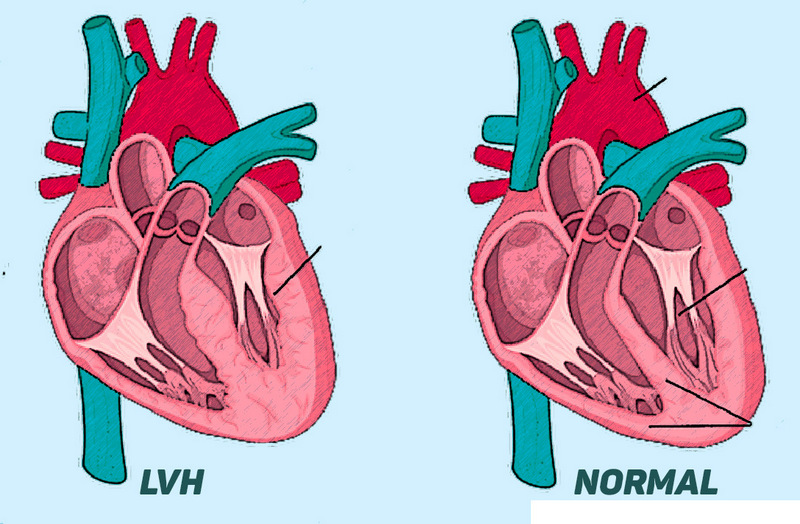- James
- 04 December, 2024
- 169
- 0
LVH and steroids
Left ventricular hypertrophy (LVH) is characterized by the thickening of the heart's left ventricle walls, the chamber responsible for pumping oxygenated blood to the body.
Remember, the heart has two lower chambers, with the right chamber or ventricle pumping blood to the lungs solely. However, the lower left chamber, or LVH, pumps blood to the rest of the body. Thus, LVH has a heavy workload, and even a minute increase in its load causes a lot of stress to the heart.
Using steroids increases muscle mass and enables individuals to train more intensively, but it also makes LVH thicker (hypertrophy in response to increased workload).
Of course, one may say that steroids also make skeletal muscles like biceps thicker, so what is wrong with it? Well, the problem is that though LVH becomes thicker and stronger, its blood supply does not increase much, and this increases the risk of heart issues, even heart attack or myocardial infarction.
While LVH can be a physiological response to intense physical training, its association with anabolic steroid use has raised significant health concerns.
Understanding Left Ventricular Hypertrophy
 LVH involves the enlargement of the myocardial cells in the left ventricle, leading to increased ventricular mass. While it can be a benign adaptation in athletes—a phenomenon known as "athlete's heart"—LVH can also result from pathological conditions such as hypertension, aortic stenosis, and cardiomyopathies.
LVH involves the enlargement of the myocardial cells in the left ventricle, leading to increased ventricular mass. While it can be a benign adaptation in athletes—a phenomenon known as "athlete's heart"—LVH can also result from pathological conditions such as hypertension, aortic stenosis, and cardiomyopathies.
Pathological LVH is associated with an elevated risk of adverse cardiovascular events, including heart failure, arrhythmias, and myocardial infarction.
Anabolic Steroids: Mechanisms and Usage
Anabolic-androgenic steroids (AAS) are synthetic derivatives of testosterone designed to promote muscle growth and enhance athletic performance. While legitimate medical uses exist for AAS, such as treating hormonal deficiencies and certain types of anemia, their non-prescribed use is prevalent in sports and bodybuilding to achieve rapid muscle hypertrophy and improved physical strength.
Steroids and the Development of LVH
Scientific studies have established a link between anabolic steroid use and the development of LVH. The mechanisms by which steroids contribute to LVH include:
1. Hormonal Imbalance and Myocardial Growth
AAS increases the levels of circulating androgens, which bind to androgen receptors in cardiac muscle cells. This interaction stimulates protein synthesis and cellular growth, leading to hypertrophic changes in the myocardium. Prolonged steroid use is associated with increased left ventricular mass and impaired diastolic function.
2. Hypertension Induction
Steroids can cause sodium and water retention, leading to elevated blood pressure. Chronic hypertension is a well-known risk factor for LVH, as the heart must work harder to pump blood against increased vascular resistance. Research in Hypertension Research (2018) demonstrated that steroid-induced hypertension significantly contributes to the development of LVH in users.
3. Altered Lipid Profiles and Atherosclerosis
AAS usage often results in adverse lipid profiles, including decreased high-density lipoprotein (HDL) and increased low-density lipoprotein (LDL) cholesterol levels. These changes promote atherosclerosis, leading to increased cardiac workload and subsequent hypertrophy.
4. Direct Myocardial Toxicity
There is evidence suggesting that AAS may have direct toxic effects on cardiac myocytes, leading to cellular apoptosis and fibrosis. This myocardial damage can contribute to structural remodeling and hypertrophy.
Health Implications of LVH Induced by Steroids
The development of LVH through steroid use carries significant health risks:
• Heart Failure: LVH can impair the heart's ability to pump blood efficiently, eventually leading to heart failure.
• Arrhythmias: Structural changes in the heart increase the risk of abnormal heart rhythms, which can be life-threatening.
• Ischemic Heart Disease: Increased myocardial mass elevates the demand for oxygen, heightening the risk of ischemia and myocardial infarction.
• Sudden Cardiac Death: The combination of LVH, arrhythmias, and ischemic heart disease significantly raises the risk of sudden cardiac death, particularly in young athletes using steroids.
Preventive Measures and Recommendations
To lower the risk of LVH associated with steroid use, the following measures are recommended:
1. Use steroids in Cycles
It is vital to use steroids in cycles so that there are resting periods during which the body can recover. Further, also avoid using steroids in extremely high dosages. It should be done gradually if one wants to increase their dose or use stacking.
2. Regular use of post-cycle therapy (PCT)
Remember that PCT is not optional but rather a must. Drugs used during PCT may help reduce the risk of side effects caused by prolonged steroid use. For example, PCT may help normalize metabolic profile, reduce cholesterol, normalize levels of other hormones, minimize stress, and more.
3. Regular Screening
When taking steroids, it is vital to engage in regular screening. One must regularly monitor blood pressure, give blood for lipid profiles, and more. Additionally, getting the cardiovascular system checked or even scanned in specialized clinics may be a good idea. Remember that only a few individuals develop LVH; some are prone to these issues, so regular screening may help prevent such issues.
Tags LVH, hearth, Left ventricular hypertrophy, health
.jpg)